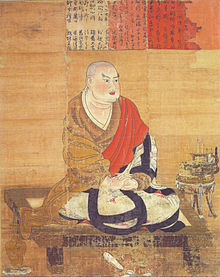Kuiji
| Kuiji |
|
|---|---|

Portrait of Jion Daishi (Kuiji), colour on silk, at Yakushi-ji (NT)
|
|
| Religion | Buddhism |
| School | East Asian Yogācāra |
| Personal | |
| Born | 632 Chang'an, China |
| Died | 682 (aged 50) |
| Religious career | |
| Teacher | Xuanzang |
Kuījī (simplified Chinese: 窥基; traditional Chinese: 窺基; 632–682), also known as Ji (Chinese: 基), an exponent of Yogācāra, was a Chinese monk and a prominent disciple of Xuanzang. His posthumous name was 慈恩大師 Cí'ēn dàshī, The Great Teacher of Cien Monastery, after the 大慈恩寺 or Great Monastery of Compassionate Grace, which was located in Changan, the main capital of the Tang Dynasty. The Giant Wild Goose Pagoda (Dayanta 大雁塔) was built in 大慈恩寺 in 652.
Kuiji's commentaries on the Cheng weishi lun and his original treatise on Yogācāra, the Fayuan yilin chang 大乘法苑義林章 ("Essays on the Forest of Meanings in the Mahāyāna Dharma Garden" became foundations of the Weishi or Faxiang School.
The Faxiang School consider Kuiji to be their first patriarch.
...
Wikipedia
